 SNOOPY
SNOOPYTurkish Delight
Alessandro Mercuri __ January 05, 2014
<> PDF
Suppose that you could mark the molecules in a glass of water, then pour the contents of the glass into the ocean and stir the latter so as to distribute the marked molecules uniformly throughout the “seven seas”; if you then took a glass of water anywhere out of the ocean, you would find in it about a hundred of your marked molecules.
Erwin Schrödinger, What is life? 1946
Across the cosmos, the lunar orbit and on the banks of the Aegean Sea, at the beginning of the year 2010, three troubling events which occurred a few days apart were reported by the press. What was bound to happen happened. A stupendous wave spread across the newsrooms overwhelmed by anxiety or surprise.
These unexpected events took place inside a star, upon the surface of the sun, but also in orbit and in Turkey.
- I -
The first piece of news concerns the heart of the solar-system, the one we call the yellow dwarf. A monster governs the firmament. Astronomers, climatologists, geophysicists agree with the fact that the sun is asleep. For two years, the sun has slept in “minimum intensity”. The longer the sleep, the more intense the dream. Does it foretell benign or cataclysmic changes? Upon the surface of the star, shadows and half-lights have disappeared. The gloomy areas, the sunspots, the usually abundant signs of magnetic forces are invisible. In restricted circles, the possibilities of a winter sun, of a new “Little Ice Age”, are evoked.
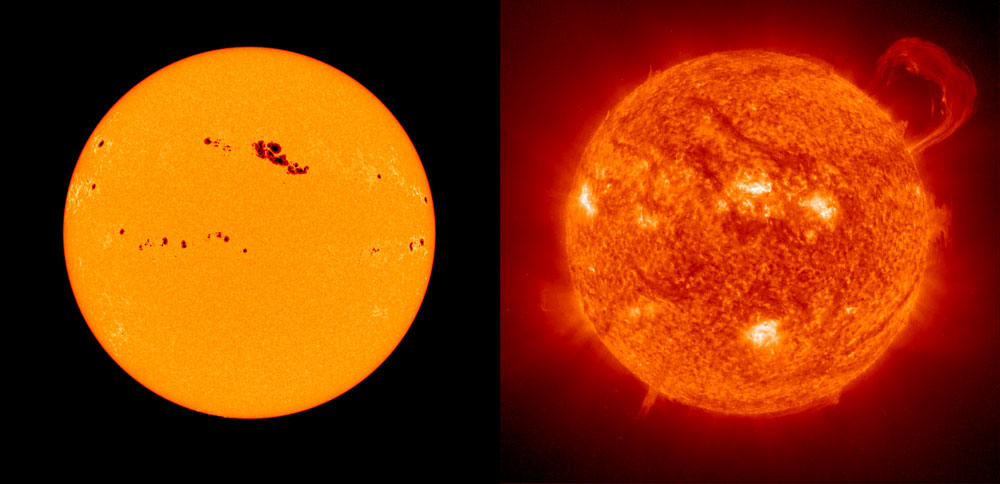
pictures of the sun (March 29, 2001 and September 14, 1999) - SOHO, ESA/NASA
The last short glaciation dates back to the time of Louis XIV. In Astronomy, the reign of the Sun King (1643-1715) coincided with the Maunder Minimum (1645-1715), a period characterized by a clear decrease in solar activity and numerous sunspots upon the surface of the star. Napoléon I supposedly wrote in his memoirs: “Hasn’t the sun got sunspots? Louis XIV was a great king. He was the one who elevated France to the top rung of nations. Since Charlemagne, which king of France can be compared to Louis XIV from every angle?”[1]
Supposedly radiant, the Sun King is actually a national fraud. The poets of the 17th century perpetuated the solar lie in describing the levee of the King touched by grace, by the rosy- red-, yellow-, green- and blue-fingered dawn. The multicolored Aurora Borealis, which set ablaze the King’s gardens in the small hours, is a myth. At the court of the Sun King, at the heart of the solar system, the eruptions, the flashes of lightning and burst of flames, gleaming hair and arches were less so. Without prominences, light bulbs, plasma bubbles or solar projection erupting in space, no iridescent spectacle, no boreal festivities can take place.
Under the reign of the astral king, the sleeping sun contributed to the wintry cold, to famines, to the resentment of an emaciated nation. The revolution sprouted up through a snow-blanketed, frost-covered country. On September 1st, 1715, a stratocumulus of moving marble adorned the monarch’s bedroom. The dying King was gazing at the features of his own bust. He feverishly contemplated his marble portrait, a cloud of stone, of scrolls and folds chiseled by le Bernin. The deathly pale King was dying, lost in the whiteness of his carved double. He murmured a few words. The priest, the chaplain, the bishop, the cardinal of the palace moved in closer to the soon-to-be-a-corpse king to take in his last whispered words. Louis was delirious and hallucinating. A horrible grin appeared on the lips of stone. A morbid breath spurted from the lips of flesh. “France dies with me but the sun will survive me”, murmured the King. It was 8.15 a.m. The sun was rising. The King was no more. The eternal soul of the nation fused with the cosmos. With the death of the King, the sun awoke. The “Little Ice Age” was completed, a solar cycle was over.

Bust of Louis XIV - Gian Lorenzo Bernini - 1665
- II -
Some centuries later, humanity sank into electricity. Once the sun set, it was broad daylight during the night: the darkness lit up, cities were illuminated. But one night, on November 9th, 1965, a violent geomagnetic storm coming from the sun poured down onto the North East of the United States. In truth, extraterrestrial particles rained down upon the entire planet, spreading across the continents and the oceans; yet just as the logo of Universal Pictures, the rotating Earth springing out of the night suddenly froze on the North American continent, the center of the world, the umbilicus of dreams, fantasies and nightmares. The same year, the Universal studios produced and distributed three films with evocative extraterrestrial titles: Shenandoah[2] with James Stewart, Pinocchio in Outer Space, a psychedelic animated movie[3], and a film deceptively entitled Mirage.[4]
In Iroquoian, Shenandoah means “Daughter of the stars”. The stellar track is launched. In Pinocchio in Outer Space, a free adaptation of Carlo Collodi’s novel, the spatial Pinocchio and Nurtle, an extraterrestrial turtle, combine their forces to fight Astro, an intergalactic, pilfering whale. Like in the phrases “beyond the grave”, “the afterlife”, Outer Space means “beyond space” in English, i.e. the universe situated beyond the terrestrial atmosphere. The doors of Outer Space open onto the threshold of the geocentric orbit while the clear blue sky deepens and darkens to be replaced by the blackness of space. The cosmic night extends into the universe, across the solar system, the Milky Way, galaxies of yellow stars, black holes, violet, purple, blood-red or green nebulas. The nose of Pinocchio becomes longer, the Milky Way flattens. The cosmos is on the screens, ready to tear apart the white canvass and come crashing down amid the spectators.
But the strangest forewarning fiction of the magnetic storm coming from the star is undoubtedly the third movie of the Universal studios: Mirage. It is almost night. The thriller film opens on an electricity failure. In New York, on the 27th floor of a skyscraper plunged into the dark, the hero, David Stillwell, a financial expert played by Gregory Peck, is about to leave the building. While going down the stairs in the bad light, armed with only an electric torch, he meets a woman calling for help.
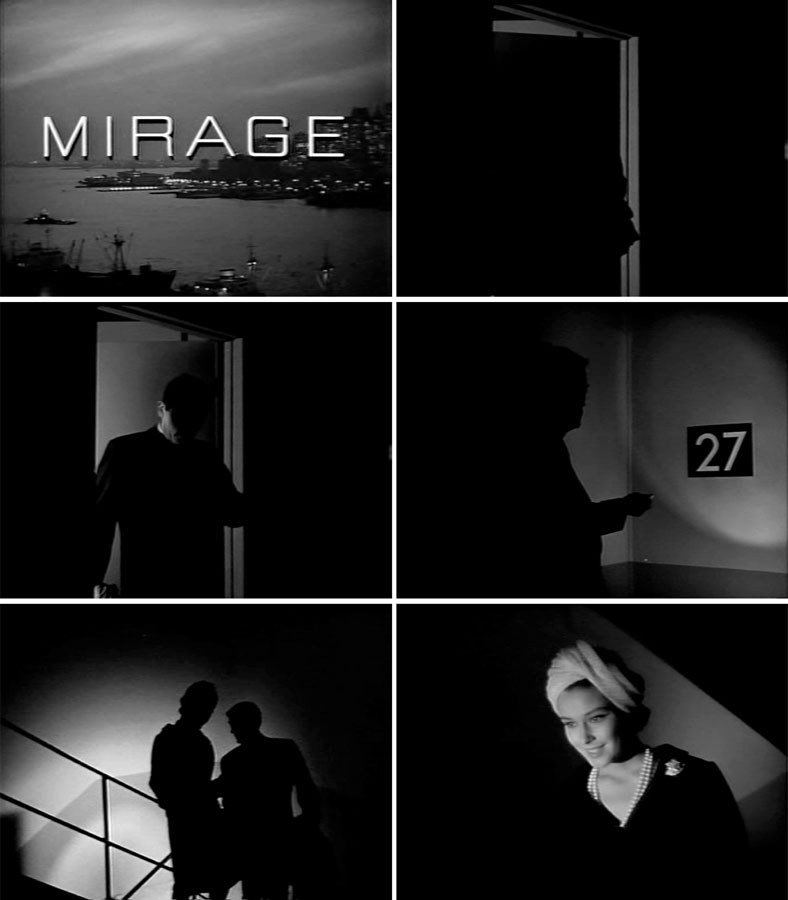
Mirage - Edward Dmytryk - 1965
The woman:
Would you help me please. It was foolish of me to start walking down alone in the dark. It’s like being buried alive. (…) I’ve never understood why most people would do things in the dark that they never think of doing in the light.
David Stillwell:
I’d explain it to you but I’m afraid the lights might come back on.
The woman:
No, I’m serious. If we can lie, cheat, steal and kill in broad daylight and have to wait till it’s dark to make love, something’s wrong somewhere.
The staircase serenade goes on and on, from the 27th floor to the ground floor, passing directly from the 14th floor to the 12th. The 13th floor does not exist because, according to Sheila, the indigenous are superstitious. Sheila is the name of the radiant woman beneath the torch of David who lights her up with a circle of light. Sheila is a whisper. A sensual murmur breathed out into the night, Sheila is of course sexy, feline and fatal. Sheila is the Celtic equivalent of the Latin Cecilia, the protective saint of the blind, of the souls lost in obscurity. Then suddenly, she is surprised and offended because the man does not recognize her.
Something’s wrong somewhere. David Stillwell is actually an amnesiac. But he doesn’t know. The electricity failure reveals it to him. Still Well. Is David Stillwell, like his name suggests, really well? Is he, as he calls himself, “still well”? Does David Stillwell know who he is? There are generally two possible postures. The Greek one and the Chinese one. Plato insists on the fact that we should “know that we do not know”, while Lao-Tzu advises us “to not know that we know”. On the one hand, the truth. On the other, something beyond reason which has absorbed the reverse of truth: concealment in spite of oneself. In osmosis with the unknown, a previously unconscious creative impetus spreads out and causes to occur what does not yet exist. David Stillwell, amnesiac, lost inside the limbo of forgetfulness, does not yet know that what he believes to be true is a larger plot, a vast conspiracy, an engineering of the real.
Mirage, a paranoid, cold-war film noir, was released on May 26th, 1965 in America and created a feeling of illusion in the spectators’ minds. Anticipatory Plagiarism[5], fiction as is often the case is a premonition, the outpouring of the dream world into real life[6].
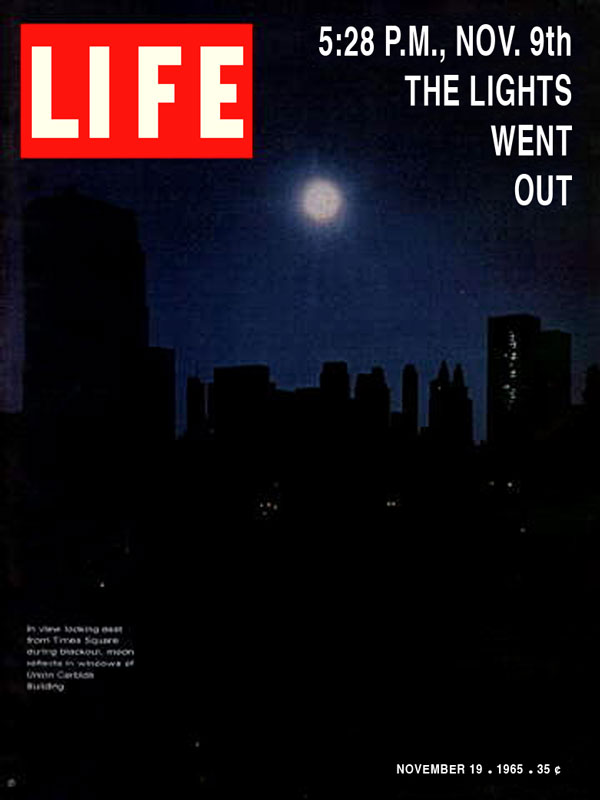
Indeed, a few months later, on the night of November 9th, 1965—a cosmic, real, universal and non-fictional night as if produced by Universal—a gigantic electrical failure plunged more than 30 million inhabitants of the East Coast into obscurity; a tremendous eruption upon the surface of our star, accompanied by a powerful solar wind, generated a magnetic storm of unparalleled violence. Solar waves and particles short-circuited a high-voltage line which conveyed electricity from the Niagara Falls power plant in Ontario, Southern Canada. The current decreased, causing a series of other lines to break in their turn. A single solar eruption—one flame of cosmic proportions, a tongue of fire licking at the terrestrial atmosphere—was enough to briefly return humanity to the stone age in the space of one night. This solar effervescence plunged the earth into night as if the overflow of light had changed back into darkness.
One by one, streetlights and neon signs went out. Some people, such as David Stillwell in Mirage, got lost in the stairs of a lightless skyscraper, while others remained trapped in elevators blocked on the hundredth floor, listening anxiously to the wind, the icy draughts which vibrated and had walls shake for hours. Off into the sky and on the ocean, planes landed in the dark, sailors watched the coastline and the lighthouses disappearing under the black waves, suspension bridges collapsing in the night. In emergency wards, surgeons plunged their scalpels into the darkness of the bodies, whose sleep was chemically induced.
Night-time is conducive to polysemy. Straight out of a film noir, the term blackout has multiple meanings: a failure of electrical power, fainting, a transient loss of consciousness or of memory. In peacetime, an electrical blackout is caused by an involuntary breakdown, by a selective power cut or by sabotage. In war time, the blackout demands lights to be put out: an electric curfew, an injunction to return to invisibility, an order to blend into the night. Just as the propaganda posters of the American and English military aimed at the civilian population throughout the Second World War:
BLACKOUT means BLACK
LOOK OUT IN THE BLACKOUT
David Stillwell, the character of Mirage, undergoes a double blackout: an electrical power failure and a loss of memory. An artificial night covers the self and plunges him into oblivion.
The collective experience of a blackout is the subject of an urban myth. The general failure of electricity would encourage fondling and cause a rise in birth rate. Allianz, the Bavarian company of compensation and life insurance, firmly denies any correlation between the number of births and the solar hurricane. For the insurance company, disaster does not rhyme with star. One should not mess with the universe. More well-disposed towards the heavens, more open-minded, the Saint Lawrence Agency, in Altamonte Springs, Florida sees the big picture. The Lawrence Agency offers an insurance policy against:
1) Unforeseen cosmic occurrence
2) UFO crimes
3) Alien abduction
4) Rape under the stars
5) Insemination aboard spaceships
6) Births in the sky
It goes without saying: the insurance also covers swab sampling of bone marrow, of spinal cord, of medulla oblongata, spatial trepanations and technological cranial implant undergone unwittingly. But no deductible could cover any debris from a space shuttle fallen into your garden or embedded into the roof of your house.
So why are there beings, something terrestrial rather than extraterrestrial? Why is there something rather than nothing? According to Heidegger, philosophy lies in this madness: due to its unlimited scope, all of the beings are equivalents. “Given the unrestricted range of the question, every being counts as much as any other. Some elephant in some jungle in India is in being just as much as some chemical oxidation process on the planet Mars, and whatever else you please.”[7]

Lewis Research Center's Electric Propulsion Laboratory, Cleveland, Ohio - NASA
With or without extraterrestrials, chilling silence hovers in the cosmos, be it finite or infinite, curved or crystalline. It is cold, it is black. It is nothingness. Petrifying, terrifying, frightening, anguished. The temperature is close to absolute zero. Stars which have been dead for millions of years, like stellar zombies, continue to shine, while on earth, extraterrestrial particles, luminous spores, solar eruptions fill us with dread.
At the beginning of 2010, the international scientific community was concerned by the low activity of the sun god. Would the star wake up from its “profound minimum”? Yes, without any doubt; though some days later, as a strange coincidence, a new though foreseeable and extraordinary event occurred. The stellar sleep gave way to a total eclipse. In the firmament, not only the sun was asleep, it also had literally disappeared. On January 15th, 2010, from Central Africa to South India, the earth, the moon and the sun were perfectly aligned. Visible from west to east, the luminous ring of the black sun went through a narrow corridor starting in the forest of the Congo basin and emerging at the mouth of the Yellow Sea. Beyond the riverbank, the annular eclipse soared and departed from the ecliptic plane. This was the event of the century, the longest lasting eclipse of the millennium. For more than ten minutes, the sun was obscured. Eternal return obliges: the scene will happen again on December 23rd, 3043.
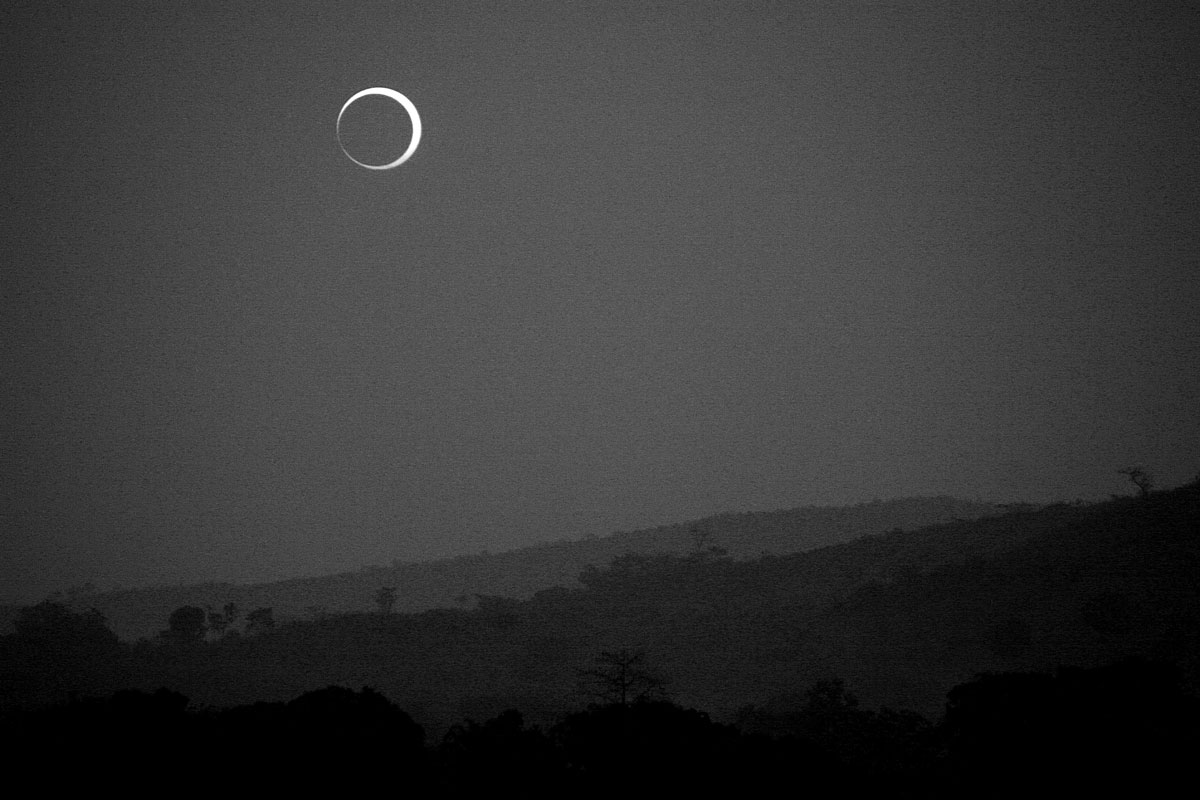
Solar eclipse - January 15, 2010 in Bangui, Central African Republic - Tino Kreutzer
Who has never felt a strange fear welling up inside of them while seeing the sun being obscured by the moon? “Goosebumps are something supernatural” wrote Rudolf Otto in The Sacred. The emotional field of the numinous, the emotional experience of the sacred, the sentiment of the mysterium tremendum, the mystery that makes one shudder, could be deciphered in an eclipse. Otto described the primitive scene in various ways: “peaceful wave, vague tranquility, sudden emergence, shocks and convulsions, strange excitations, intoxication, transport, ecstasy, savage and demonic forms, thrills, shock horror, terror, sinister…” If the eclipse is predictable and measurable, its effects on man remain strangely timeless; a primitive, elementary, naive and brutal manifestation.
In the sky a black hole sparkles in a luminous circle. The succession of day and night is suspended. The bats are awoken and flap their wings. The wolves and the jackals, upset by the darkness, shaken out of their torpor, leave their burrows and howl at the full moon in the sunlight. The penumbra shrouds the daylight. The eclipse is not a twilight but a collusion and a monstrous coexistence of the light and the darkness. The diurnal world subsides in the reign of the night. Vampires and werewolves are disorientated. In the light from the beyond, faces become deathly pale and greenish. The harpies leap out of hell, the incubi are horny, the ghouls are hooded. Nymphomaniac succubi and evil spirits. Lilith and Satan are dancing the tango. Waves of fear run through your bones. “Goosebumps are something supernatural.” The doors of the kingdom of the dead open, the nightmare of the afterlife flows over... over ... incredulous souls beware: don’t go further.
Archaic superstition is often disparaged. The etymology of the word reveals a common origin that can be vulgar and misleading: idolatry and cult of false gods. The effect of the eclipse might be an illusion. Barely credible, it reminds us of the nuit américaine, the cinematographic special effect consisting in the simulation of a night scene filmed in daylight, the simulation of the sun under the moonlight: Day for Night. From Ben-Hur to Tintoretto, from Hollywood to Venice, the bluish or ochre crucifixions describe a landscape both diurnal and nocturnal, as if struck by a total eclipse of the sun. For that matter, the event was observed in Jerusalem on November 24th, 29 A.D.
Now from the sixth hour it was dark over all the land till the ninth hour.
Matthew (27:45-46)
At Borgo San Sepolcro, in the church of San Lorenzo, the Descent from the Cross of the mannerist painter Rosso Fiorentino seems also situated in the shadow of the moon, the alignment of a planet, a satellite and a star. The onlookers plunge their gaze into the prominent ribs of Christ, the suffering and the swooning of the Virgin. Further away, in the background, under the cross, a bloodcurdling apparition emerges out from the darkness. Hair in the wind, an infernal, demonic, grotesque and formless face stares at you. The unexpected, incongruous presence of the monster overwhelms the visitor. Neither hidden nor exposed, the Devil is here. Yet you must wait until the eye gets accustomed to the painted half-light, to the gloom that covers the canvass. Still invisible, the vision of the demon will become even more troubling, his presence more striking. Stendhal syndrome in reverse, we reach an emotional point where the celestial, macabre and diabolical sensations meet. The frissons of anguish by Rosso Fiorentino echoes the Profondo Rosso of Dario Argento. In the black of the canvass, everything quivers in fear.
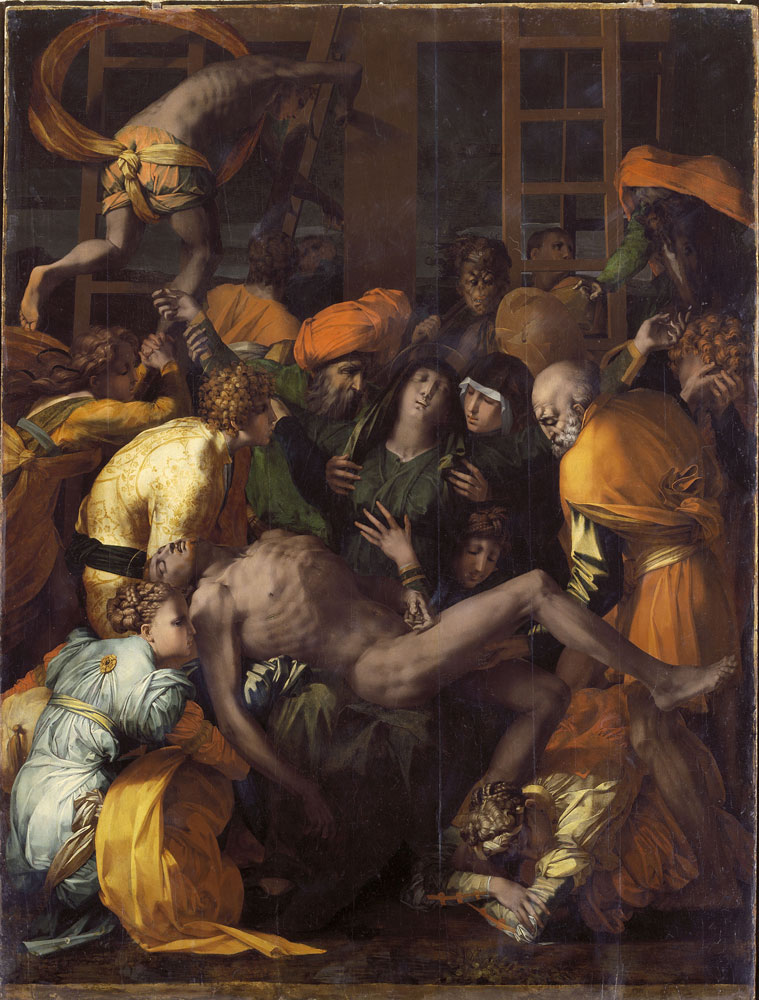
Descent from the Cross - Rosso Fiorentino - 1528
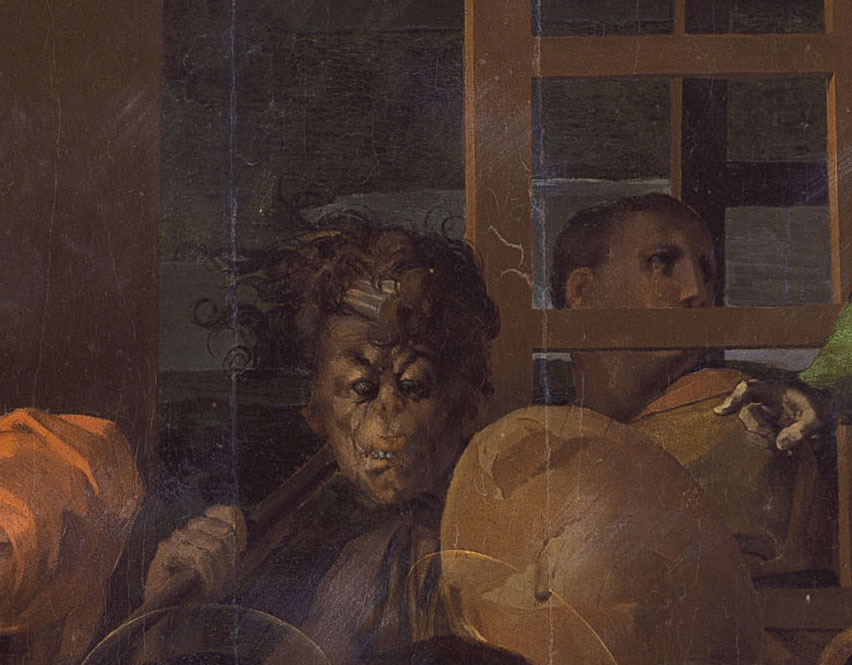
Descent from the Cross - Rosso Fiorentino - 1528 - detail
The oil on canvass by Rosso Fiorentino, dated 1528, is mentioned by Vasari in Le Vite (1550)—Lives of the Most Excellent Italian Painters, Sculptors, and Architects. The painting, contemporary of the art critic, is described in the following way: "This descent from the Cross, executed with great care, is also remarkable because of something tenebrous somehow in the colors supposed to render the eclipse which happened at the time of the death of Christ." The eclipse and its light must be considered a major pictorial motif whose aesthetic issues coincide with the importance of the religious theme. The pallid eclipse, the mannerist light par excellence, is oxymoronic (day for night), represents the meeting of opposites, dark and bright at the same time, between enchantment and sorcery. From the Aztecs to the Christians, might the eclipse be conducive to human sacrifices? Is the eclipse a harbinger of fateful, unnatural and monstrous omens? Is the alignment of the stars only a precursory, enlightening sign, or rather a harmful one? At the beginning of 2010, the sun is in the headlines. Dreaming of magnetic storms, of fire eruptions, asleep or obscured by the moon, on the banks of the Aegean Sea, in the wake of the eclipse, a third event is about to occur.
- III -
What was bound to happen happened. The sun was asleep, the sun was eclipsed and, the next morning, on January 16th, 2010, like any other mornings, the sun rose anew on the ancient Roman port of Ephesus in Turkey. The port had disappeared. The waves were silent. The Aegean Sea had withdrawn into the distance. The long marble avenue leading to the open sea was lost in the undergrowth, the weeds and the sand. In the gardens of the agora, a birth cry sounding like a bleating rang out in the shadow of the columns and the leaves of acanthus. A lamb was born.

Library of Celsus - Ephesus - 135 A.D.
The scene happened actually in a village of the province of Izmir, not far from Ephesus. The tableau was less mythological, more clinical and realistic. According to the Daily Telegraph, an Australian tabloid paper owned by the media magnate Rupert Murdoch, a sheep gave birth to a hybrid creature: a lamb with a human face. Erhan Elibol, a vet, performed a caesarean on the animal to take the lamb out. He corroborated: “I’ve seen mutations with cows and sheep before. I’ve seen a one-eyed calf, a two-headed calf, a five-legged calf. But when I saw this youngster I could not believe my eyes.” CNN Turkey was the first to report it, with the photograph of the part human, part lamb animal to support the evidence. Its fleece was speckled with placenta. The head resembled an idol of the Cyclades. The face was oblong, hominoid. Its forehead was covered in wool. Its ears were nothing like a human’s. Its eyelids were closed. The outlines of a small nose, a thick-lipped mouth and an alabaster chin were carved in the flesh. The rest of the body was shriveled up like that of a huddled lamb. The beast died at birth. No one could say if the lamb, once become a ram, the golden-horned animal, would have been able to speak. Then it unfolded its wings in the sky and flew among the blazingly white clouds. At first idolized, the creature was eventually sacrificed upon the altar of false gods, tortured and dismembered. A new golden fleece?
The veterinary suggested that this rare mutation might have been caused by an overabundance of Vitamin A in the feed. The hypothesis is questionable. Anyway the photo is clear, the metamorphosis is indisputable. A satyr of modern times, with the dna of the Danaids, the mutant creature was born at the time of the eclipse, like the demonic monster which sprang up from the dark crucifixion. The governor of the Izmir province reportedly said: "This incident is very shocking. It is the first time I see such an evil thing. It is really embarrassing. The head belongs to a man while the body is that of a sheep. This is evident that an adult human being was responsible. Unfortunately, evil powers caused this person to lose self-control. We often hear of cases of human beings who commit bestiality but this is the first time for such an act to produce an animal with human features.” Can we question the words of the governor of Izmir or imagine that what he said was entirely invented?
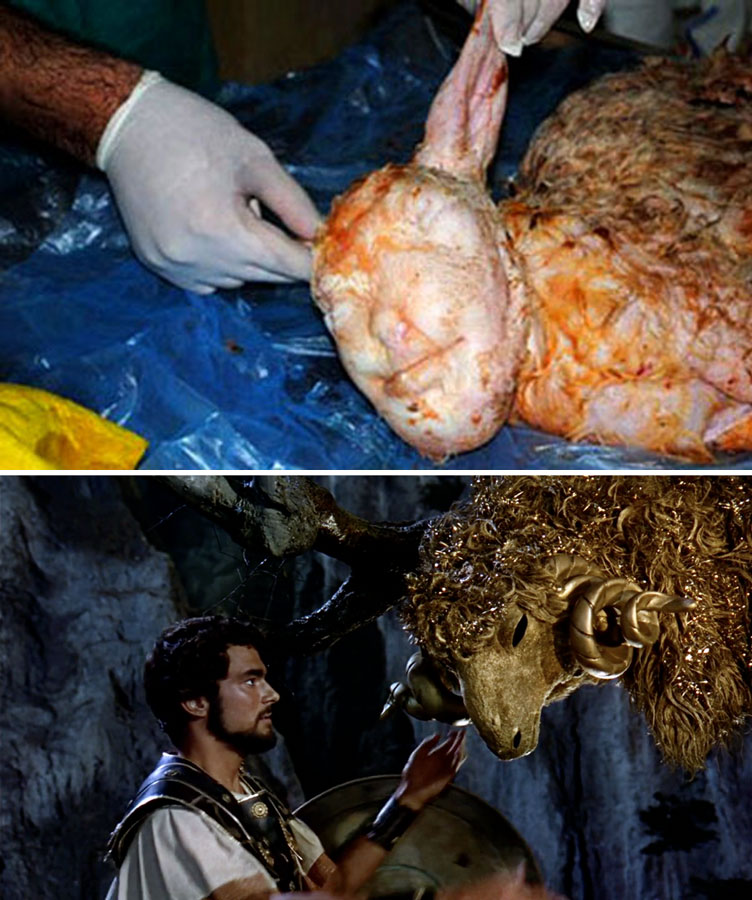
Man-sheep or Sheep-man / Jason and the Argonauts - Don Chaffey - 1963
If the lamb with a human face seems to be an unlikely phenomenon, however, we cannot deny the medically proven existence of the man with the liver of a baboon. It is not a myth but a xenogeneic transplantation. After the Roswell Alien, after Dolly, the genetically manipulated sheep, the first clone of a mammal (in Scotland, homeland of the Loch Ness): the creature from Izmir, the fruit of a monstrous love between a man and a ewe. Man-sheep, sheep-man: the guilt of man and the innocence of sheep. Rumor, hoax, staged phenomenon or implausible truth? The event was reported by the Daily Telegraph, CNN Turkey but also by La Tribune de Genève and the English edition of Pravda.
Nature like the media abounds in the spectacular, the sensational, lies and dissimulation. In the kingdom of fiction, the marvelous or monstrous creature of Izmir is not more or less credible than the Metamorphoses of Ovid. In the kingdom of living things, deception is an evolutionary strategy. It is also to be found in the art of mimicry and camouflage.
The stick-insect is protean—a twig, a veined, indented, torn-down, bronze and green leaf or a fallen leaf. The insect mimics vegetal flesh and its movements in the wind in such a realistic way that a paranormal dialogue seems to be going on in the natural world. Lies and mystery. Mimesis is misleading, mimesis is magic. What is false does not sanction any more the illusion of appearances, of the surface, of the misleading and interchangeable mask: it defines the very nature of the self. The stick-insect is what it is not. The stick insect is twig or chlorophyll and speaks the supersensible language of the vegetable matter.

Phasmatodea
The close encounter of the third kind between man and extraterrestrial has already taken place between the stick insect and the leaf. Natural simulation, super realistic avatar, is the stick insect—or phasmatodea, from the Ancient Greek phasma, meaning phantom—the manifestation of a more complex intelligence, more creative than the painfully scientistic human imaginings? Hallucinatory, pretense, confusing the vegetable and the animal, the stick insect lets out confused words and moves through forests of symbols. From the stick insect to the leaf, from the thorns of the rose to the predator, from the carnivorous plant to the vegetarian, a vitalistic current flows in the kingdom of living things. As for man, he dreams of travelling the cosmos, the lunar orbit and the banks of the Aegean Sea, searching for new extraordinary, extraterrestrial and imaginary creatures. Are human beings just star dust, like Shenandoah, the character of the Universal film? Memento, homo, quad pulvis es, et in pulverem reverteris. “Remember, man, you are dust and to dust you will return.” To star dust you will return.
Suppose that you could mark the molecules in a glass of water, then pour the contents of the glass into the ocean and stir the latter so as to distribute the marked molecules uniformly throughout the “seven seas”; if you then took a glass of water anywhere out of the ocean, you would find in it about a hundred of your marked molecules.
Erwin Schrödinger, What is life? 1946
Across the cosmos, the lunar orbit and on the banks of the Aegean Sea, at the beginning of the year 2010, three troubling events which occurred a few days apart were reported by the press. What was bound to happen happened. A stupendous wave spread across the newsrooms overwhelmed by anxiety or surprise.
These unexpected events took place inside a star, upon the surface of the sun, but also in orbit and in Turkey.
- I -
The first piece of news concerns the heart of the solar-system, the one we call the yellow dwarf. A monster governs the firmament. Astronomers, climatologists, geophysicists agree with the fact that the sun is asleep. For two years, the sun has slept in “minimum intensity”. The longer the sleep, the more intense the dream. Does it foretell benign or cataclysmic changes? Upon the surface of the star, shadows and half-lights have disappeared. The gloomy areas, the sunspots, the usually abundant signs of magnetic forces are invisible. In restricted circles, the possibilities of a winter sun, of a new “Little Ice Age”, are evoked.

pictures of the sun (March 29, 2001 and September 14, 1999) - SOHO, ESA/NASA
The last short glaciation dates back to the time of Louis XIV. In Astronomy, the reign of the Sun King (1643-1715) coincided with the Maunder Minimum (1645-1715), a period characterized by a clear decrease in solar activity and numerous sunspots upon the surface of the star. Napoléon I supposedly wrote in his memoirs: “Hasn’t the sun got sunspots? Louis XIV was a great king. He was the one who elevated France to the top rung of nations. Since Charlemagne, which king of France can be compared to Louis XIV from every angle?”[1]
Supposedly radiant, the Sun King is actually a national fraud. The poets of the 17th century perpetuated the solar lie in describing the levee of the King touched by grace, by the rosy- red-, yellow-, green- and blue-fingered dawn. The multicolored Aurora Borealis, which set ablaze the King’s gardens in the small hours, is a myth. At the court of the Sun King, at the heart of the solar system, the eruptions, the flashes of lightning and burst of flames, gleaming hair and arches were less so. Without prominences, light bulbs, plasma bubbles or solar projection erupting in space, no iridescent spectacle, no boreal festivities can take place.
Under the reign of the astral king, the sleeping sun contributed to the wintry cold, to famines, to the resentment of an emaciated nation. The revolution sprouted up through a snow-blanketed, frost-covered country. On September 1st, 1715, a stratocumulus of moving marble adorned the monarch’s bedroom. The dying King was gazing at the features of his own bust. He feverishly contemplated his marble portrait, a cloud of stone, of scrolls and folds chiseled by le Bernin. The deathly pale King was dying, lost in the whiteness of his carved double. He murmured a few words. The priest, the chaplain, the bishop, the cardinal of the palace moved in closer to the soon-to-be-a-corpse king to take in his last whispered words. Louis was delirious and hallucinating. A horrible grin appeared on the lips of stone. A morbid breath spurted from the lips of flesh. “France dies with me but the sun will survive me”, murmured the King. It was 8.15 a.m. The sun was rising. The King was no more. The eternal soul of the nation fused with the cosmos. With the death of the King, the sun awoke. The “Little Ice Age” was completed, a solar cycle was over.

Bust of Louis XIV - Gian Lorenzo Bernini - 1665
- II -
Some centuries later, humanity sank into electricity. Once the sun set, it was broad daylight during the night: the darkness lit up, cities were illuminated. But one night, on November 9th, 1965, a violent geomagnetic storm coming from the sun poured down onto the North East of the United States. In truth, extraterrestrial particles rained down upon the entire planet, spreading across the continents and the oceans; yet just as the logo of Universal Pictures, the rotating Earth springing out of the night suddenly froze on the North American continent, the center of the world, the umbilicus of dreams, fantasies and nightmares. The same year, the Universal studios produced and distributed three films with evocative extraterrestrial titles: Shenandoah[2] with James Stewart, Pinocchio in Outer Space, a psychedelic animated movie[3], and a film deceptively entitled Mirage.[4]
In Iroquoian, Shenandoah means “Daughter of the stars”. The stellar track is launched. In Pinocchio in Outer Space, a free adaptation of Carlo Collodi’s novel, the spatial Pinocchio and Nurtle, an extraterrestrial turtle, combine their forces to fight Astro, an intergalactic, pilfering whale. Like in the phrases “beyond the grave”, “the afterlife”, Outer Space means “beyond space” in English, i.e. the universe situated beyond the terrestrial atmosphere. The doors of Outer Space open onto the threshold of the geocentric orbit while the clear blue sky deepens and darkens to be replaced by the blackness of space. The cosmic night extends into the universe, across the solar system, the Milky Way, galaxies of yellow stars, black holes, violet, purple, blood-red or green nebulas. The nose of Pinocchio becomes longer, the Milky Way flattens. The cosmos is on the screens, ready to tear apart the white canvass and come crashing down amid the spectators.
But the strangest forewarning fiction of the magnetic storm coming from the star is undoubtedly the third movie of the Universal studios: Mirage. It is almost night. The thriller film opens on an electricity failure. In New York, on the 27th floor of a skyscraper plunged into the dark, the hero, David Stillwell, a financial expert played by Gregory Peck, is about to leave the building. While going down the stairs in the bad light, armed with only an electric torch, he meets a woman calling for help.

Mirage - Edward Dmytryk - 1965
The woman:
Would you help me please. It was foolish of me to start walking down alone in the dark. It’s like being buried alive. (…) I’ve never understood why most people would do things in the dark that they never think of doing in the light.
David Stillwell:
I’d explain it to you but I’m afraid the lights might come back on.
The woman:
No, I’m serious. If we can lie, cheat, steal and kill in broad daylight and have to wait till it’s dark to make love, something’s wrong somewhere.
The staircase serenade goes on and on, from the 27th floor to the ground floor, passing directly from the 14th floor to the 12th. The 13th floor does not exist because, according to Sheila, the indigenous are superstitious. Sheila is the name of the radiant woman beneath the torch of David who lights her up with a circle of light. Sheila is a whisper. A sensual murmur breathed out into the night, Sheila is of course sexy, feline and fatal. Sheila is the Celtic equivalent of the Latin Cecilia, the protective saint of the blind, of the souls lost in obscurity. Then suddenly, she is surprised and offended because the man does not recognize her.
Something’s wrong somewhere. David Stillwell is actually an amnesiac. But he doesn’t know. The electricity failure reveals it to him. Still Well. Is David Stillwell, like his name suggests, really well? Is he, as he calls himself, “still well”? Does David Stillwell know who he is? There are generally two possible postures. The Greek one and the Chinese one. Plato insists on the fact that we should “know that we do not know”, while Lao-Tzu advises us “to not know that we know”. On the one hand, the truth. On the other, something beyond reason which has absorbed the reverse of truth: concealment in spite of oneself. In osmosis with the unknown, a previously unconscious creative impetus spreads out and causes to occur what does not yet exist. David Stillwell, amnesiac, lost inside the limbo of forgetfulness, does not yet know that what he believes to be true is a larger plot, a vast conspiracy, an engineering of the real.
Mirage, a paranoid, cold-war film noir, was released on May 26th, 1965 in America and created a feeling of illusion in the spectators’ minds. Anticipatory Plagiarism[5], fiction as is often the case is a premonition, the outpouring of the dream world into real life[6].

Indeed, a few months later, on the night of November 9th, 1965—a cosmic, real, universal and non-fictional night as if produced by Universal—a gigantic electrical failure plunged more than 30 million inhabitants of the East Coast into obscurity; a tremendous eruption upon the surface of our star, accompanied by a powerful solar wind, generated a magnetic storm of unparalleled violence. Solar waves and particles short-circuited a high-voltage line which conveyed electricity from the Niagara Falls power plant in Ontario, Southern Canada. The current decreased, causing a series of other lines to break in their turn. A single solar eruption—one flame of cosmic proportions, a tongue of fire licking at the terrestrial atmosphere—was enough to briefly return humanity to the stone age in the space of one night. This solar effervescence plunged the earth into night as if the overflow of light had changed back into darkness.
One by one, streetlights and neon signs went out. Some people, such as David Stillwell in Mirage, got lost in the stairs of a lightless skyscraper, while others remained trapped in elevators blocked on the hundredth floor, listening anxiously to the wind, the icy draughts which vibrated and had walls shake for hours. Off into the sky and on the ocean, planes landed in the dark, sailors watched the coastline and the lighthouses disappearing under the black waves, suspension bridges collapsing in the night. In emergency wards, surgeons plunged their scalpels into the darkness of the bodies, whose sleep was chemically induced.
Night-time is conducive to polysemy. Straight out of a film noir, the term blackout has multiple meanings: a failure of electrical power, fainting, a transient loss of consciousness or of memory. In peacetime, an electrical blackout is caused by an involuntary breakdown, by a selective power cut or by sabotage. In war time, the blackout demands lights to be put out: an electric curfew, an injunction to return to invisibility, an order to blend into the night. Just as the propaganda posters of the American and English military aimed at the civilian population throughout the Second World War:
BLACKOUT means BLACK
LOOK OUT IN THE BLACKOUT
David Stillwell, the character of Mirage, undergoes a double blackout: an electrical power failure and a loss of memory. An artificial night covers the self and plunges him into oblivion.
The collective experience of a blackout is the subject of an urban myth. The general failure of electricity would encourage fondling and cause a rise in birth rate. Allianz, the Bavarian company of compensation and life insurance, firmly denies any correlation between the number of births and the solar hurricane. For the insurance company, disaster does not rhyme with star. One should not mess with the universe. More well-disposed towards the heavens, more open-minded, the Saint Lawrence Agency, in Altamonte Springs, Florida sees the big picture. The Lawrence Agency offers an insurance policy against:
1) Unforeseen cosmic occurrence
2) UFO crimes
3) Alien abduction
4) Rape under the stars
5) Insemination aboard spaceships
6) Births in the sky
It goes without saying: the insurance also covers swab sampling of bone marrow, of spinal cord, of medulla oblongata, spatial trepanations and technological cranial implant undergone unwittingly. But no deductible could cover any debris from a space shuttle fallen into your garden or embedded into the roof of your house.
So why are there beings, something terrestrial rather than extraterrestrial? Why is there something rather than nothing? According to Heidegger, philosophy lies in this madness: due to its unlimited scope, all of the beings are equivalents. “Given the unrestricted range of the question, every being counts as much as any other. Some elephant in some jungle in India is in being just as much as some chemical oxidation process on the planet Mars, and whatever else you please.”[7]

Lewis Research Center's Electric Propulsion Laboratory, Cleveland, Ohio - NASA
With or without extraterrestrials, chilling silence hovers in the cosmos, be it finite or infinite, curved or crystalline. It is cold, it is black. It is nothingness. Petrifying, terrifying, frightening, anguished. The temperature is close to absolute zero. Stars which have been dead for millions of years, like stellar zombies, continue to shine, while on earth, extraterrestrial particles, luminous spores, solar eruptions fill us with dread.
At the beginning of 2010, the international scientific community was concerned by the low activity of the sun god. Would the star wake up from its “profound minimum”? Yes, without any doubt; though some days later, as a strange coincidence, a new though foreseeable and extraordinary event occurred. The stellar sleep gave way to a total eclipse. In the firmament, not only the sun was asleep, it also had literally disappeared. On January 15th, 2010, from Central Africa to South India, the earth, the moon and the sun were perfectly aligned. Visible from west to east, the luminous ring of the black sun went through a narrow corridor starting in the forest of the Congo basin and emerging at the mouth of the Yellow Sea. Beyond the riverbank, the annular eclipse soared and departed from the ecliptic plane. This was the event of the century, the longest lasting eclipse of the millennium. For more than ten minutes, the sun was obscured. Eternal return obliges: the scene will happen again on December 23rd, 3043.

Solar eclipse - January 15, 2010 in Bangui, Central African Republic - Tino Kreutzer
Who has never felt a strange fear welling up inside of them while seeing the sun being obscured by the moon? “Goosebumps are something supernatural” wrote Rudolf Otto in The Sacred. The emotional field of the numinous, the emotional experience of the sacred, the sentiment of the mysterium tremendum, the mystery that makes one shudder, could be deciphered in an eclipse. Otto described the primitive scene in various ways: “peaceful wave, vague tranquility, sudden emergence, shocks and convulsions, strange excitations, intoxication, transport, ecstasy, savage and demonic forms, thrills, shock horror, terror, sinister…” If the eclipse is predictable and measurable, its effects on man remain strangely timeless; a primitive, elementary, naive and brutal manifestation.
In the sky a black hole sparkles in a luminous circle. The succession of day and night is suspended. The bats are awoken and flap their wings. The wolves and the jackals, upset by the darkness, shaken out of their torpor, leave their burrows and howl at the full moon in the sunlight. The penumbra shrouds the daylight. The eclipse is not a twilight but a collusion and a monstrous coexistence of the light and the darkness. The diurnal world subsides in the reign of the night. Vampires and werewolves are disorientated. In the light from the beyond, faces become deathly pale and greenish. The harpies leap out of hell, the incubi are horny, the ghouls are hooded. Nymphomaniac succubi and evil spirits. Lilith and Satan are dancing the tango. Waves of fear run through your bones. “Goosebumps are something supernatural.” The doors of the kingdom of the dead open, the nightmare of the afterlife flows over... over ... incredulous souls beware: don’t go further.
Archaic superstition is often disparaged. The etymology of the word reveals a common origin that can be vulgar and misleading: idolatry and cult of false gods. The effect of the eclipse might be an illusion. Barely credible, it reminds us of the nuit américaine, the cinematographic special effect consisting in the simulation of a night scene filmed in daylight, the simulation of the sun under the moonlight: Day for Night. From Ben-Hur to Tintoretto, from Hollywood to Venice, the bluish or ochre crucifixions describe a landscape both diurnal and nocturnal, as if struck by a total eclipse of the sun. For that matter, the event was observed in Jerusalem on November 24th, 29 A.D.
Now from the sixth hour it was dark over all the land till the ninth hour.
Matthew (27:45-46)
At Borgo San Sepolcro, in the church of San Lorenzo, the Descent from the Cross of the mannerist painter Rosso Fiorentino seems also situated in the shadow of the moon, the alignment of a planet, a satellite and a star. The onlookers plunge their gaze into the prominent ribs of Christ, the suffering and the swooning of the Virgin. Further away, in the background, under the cross, a bloodcurdling apparition emerges out from the darkness. Hair in the wind, an infernal, demonic, grotesque and formless face stares at you. The unexpected, incongruous presence of the monster overwhelms the visitor. Neither hidden nor exposed, the Devil is here. Yet you must wait until the eye gets accustomed to the painted half-light, to the gloom that covers the canvass. Still invisible, the vision of the demon will become even more troubling, his presence more striking. Stendhal syndrome in reverse, we reach an emotional point where the celestial, macabre and diabolical sensations meet. The frissons of anguish by Rosso Fiorentino echoes the Profondo Rosso of Dario Argento. In the black of the canvass, everything quivers in fear.

Descent from the Cross - Rosso Fiorentino - 1528

Descent from the Cross - Rosso Fiorentino - 1528 - detail
The oil on canvass by Rosso Fiorentino, dated 1528, is mentioned by Vasari in Le Vite (1550)—Lives of the Most Excellent Italian Painters, Sculptors, and Architects. The painting, contemporary of the art critic, is described in the following way: "This descent from the Cross, executed with great care, is also remarkable because of something tenebrous somehow in the colors supposed to render the eclipse which happened at the time of the death of Christ." The eclipse and its light must be considered a major pictorial motif whose aesthetic issues coincide with the importance of the religious theme. The pallid eclipse, the mannerist light par excellence, is oxymoronic (day for night), represents the meeting of opposites, dark and bright at the same time, between enchantment and sorcery. From the Aztecs to the Christians, might the eclipse be conducive to human sacrifices? Is the eclipse a harbinger of fateful, unnatural and monstrous omens? Is the alignment of the stars only a precursory, enlightening sign, or rather a harmful one? At the beginning of 2010, the sun is in the headlines. Dreaming of magnetic storms, of fire eruptions, asleep or obscured by the moon, on the banks of the Aegean Sea, in the wake of the eclipse, a third event is about to occur.
- III -
What was bound to happen happened. The sun was asleep, the sun was eclipsed and, the next morning, on January 16th, 2010, like any other mornings, the sun rose anew on the ancient Roman port of Ephesus in Turkey. The port had disappeared. The waves were silent. The Aegean Sea had withdrawn into the distance. The long marble avenue leading to the open sea was lost in the undergrowth, the weeds and the sand. In the gardens of the agora, a birth cry sounding like a bleating rang out in the shadow of the columns and the leaves of acanthus. A lamb was born.

Library of Celsus - Ephesus - 135 A.D.
The scene happened actually in a village of the province of Izmir, not far from Ephesus. The tableau was less mythological, more clinical and realistic. According to the Daily Telegraph, an Australian tabloid paper owned by the media magnate Rupert Murdoch, a sheep gave birth to a hybrid creature: a lamb with a human face. Erhan Elibol, a vet, performed a caesarean on the animal to take the lamb out. He corroborated: “I’ve seen mutations with cows and sheep before. I’ve seen a one-eyed calf, a two-headed calf, a five-legged calf. But when I saw this youngster I could not believe my eyes.” CNN Turkey was the first to report it, with the photograph of the part human, part lamb animal to support the evidence. Its fleece was speckled with placenta. The head resembled an idol of the Cyclades. The face was oblong, hominoid. Its forehead was covered in wool. Its ears were nothing like a human’s. Its eyelids were closed. The outlines of a small nose, a thick-lipped mouth and an alabaster chin were carved in the flesh. The rest of the body was shriveled up like that of a huddled lamb. The beast died at birth. No one could say if the lamb, once become a ram, the golden-horned animal, would have been able to speak. Then it unfolded its wings in the sky and flew among the blazingly white clouds. At first idolized, the creature was eventually sacrificed upon the altar of false gods, tortured and dismembered. A new golden fleece?
The veterinary suggested that this rare mutation might have been caused by an overabundance of Vitamin A in the feed. The hypothesis is questionable. Anyway the photo is clear, the metamorphosis is indisputable. A satyr of modern times, with the dna of the Danaids, the mutant creature was born at the time of the eclipse, like the demonic monster which sprang up from the dark crucifixion. The governor of the Izmir province reportedly said: "This incident is very shocking. It is the first time I see such an evil thing. It is really embarrassing. The head belongs to a man while the body is that of a sheep. This is evident that an adult human being was responsible. Unfortunately, evil powers caused this person to lose self-control. We often hear of cases of human beings who commit bestiality but this is the first time for such an act to produce an animal with human features.” Can we question the words of the governor of Izmir or imagine that what he said was entirely invented?

Man-sheep or Sheep-man / Jason and the Argonauts - Don Chaffey - 1963
If the lamb with a human face seems to be an unlikely phenomenon, however, we cannot deny the medically proven existence of the man with the liver of a baboon. It is not a myth but a xenogeneic transplantation. After the Roswell Alien, after Dolly, the genetically manipulated sheep, the first clone of a mammal (in Scotland, homeland of the Loch Ness): the creature from Izmir, the fruit of a monstrous love between a man and a ewe. Man-sheep, sheep-man: the guilt of man and the innocence of sheep. Rumor, hoax, staged phenomenon or implausible truth? The event was reported by the Daily Telegraph, CNN Turkey but also by La Tribune de Genève and the English edition of Pravda.
Nature like the media abounds in the spectacular, the sensational, lies and dissimulation. In the kingdom of fiction, the marvelous or monstrous creature of Izmir is not more or less credible than the Metamorphoses of Ovid. In the kingdom of living things, deception is an evolutionary strategy. It is also to be found in the art of mimicry and camouflage.
The stick-insect is protean—a twig, a veined, indented, torn-down, bronze and green leaf or a fallen leaf. The insect mimics vegetal flesh and its movements in the wind in such a realistic way that a paranormal dialogue seems to be going on in the natural world. Lies and mystery. Mimesis is misleading, mimesis is magic. What is false does not sanction any more the illusion of appearances, of the surface, of the misleading and interchangeable mask: it defines the very nature of the self. The stick-insect is what it is not. The stick insect is twig or chlorophyll and speaks the supersensible language of the vegetable matter.

Phasmatodea
The close encounter of the third kind between man and extraterrestrial has already taken place between the stick insect and the leaf. Natural simulation, super realistic avatar, is the stick insect—or phasmatodea, from the Ancient Greek phasma, meaning phantom—the manifestation of a more complex intelligence, more creative than the painfully scientistic human imaginings? Hallucinatory, pretense, confusing the vegetable and the animal, the stick insect lets out confused words and moves through forests of symbols. From the stick insect to the leaf, from the thorns of the rose to the predator, from the carnivorous plant to the vegetarian, a vitalistic current flows in the kingdom of living things. As for man, he dreams of travelling the cosmos, the lunar orbit and the banks of the Aegean Sea, searching for new extraordinary, extraterrestrial and imaginary creatures. Are human beings just star dust, like Shenandoah, the character of the Universal film? Memento, homo, quad pulvis es, et in pulverem reverteris. “Remember, man, you are dust and to dust you will return.” To star dust you will return.
Translated from the French by Paul Stubbs & Blandine Longre
[1] In Imbert de Saint Amand, The Court of Louis XIV, 1886.
[2] A film by Andrew V. McLaglen, 1965.
[3] A film by Ray Goossens, 1965.
[4] A film by Edward Dmytryk, 1965.
[5] Pierre Bayard, Anticipatory Plagiarism, Les Éditions de Minuit, 2009.
[6] Gérard de Nerval, Aurélia, 1855.
[7] Martin Heidegger, Introduction to Metaphysics, 1952.
TAGS : Alessandro Mercuri, Turkish Delight, Erwin Schrödinger, What is life?, minimum intensity, Little Ice Age, Maunder Minimum, November 9th 1965, geomagnetic storm, Mirage, Edward Dmytryk, David Stillwell, blackout, Saint Lawrence Agency, Rudolf Otto, Day for night, Borgo San Sepolcro, Church of San Lorenzo, Descent from the Cross, Rosso Fiorentino, Stendhal syndrome, Profondo Rosso, Dario Argento, Vasari, Le Vite, Ephesus, lamb, Erhan Elibol, Dolly, genetically manipulated sheep, creature of Izmir, stick-insect
NEXT POST >>










